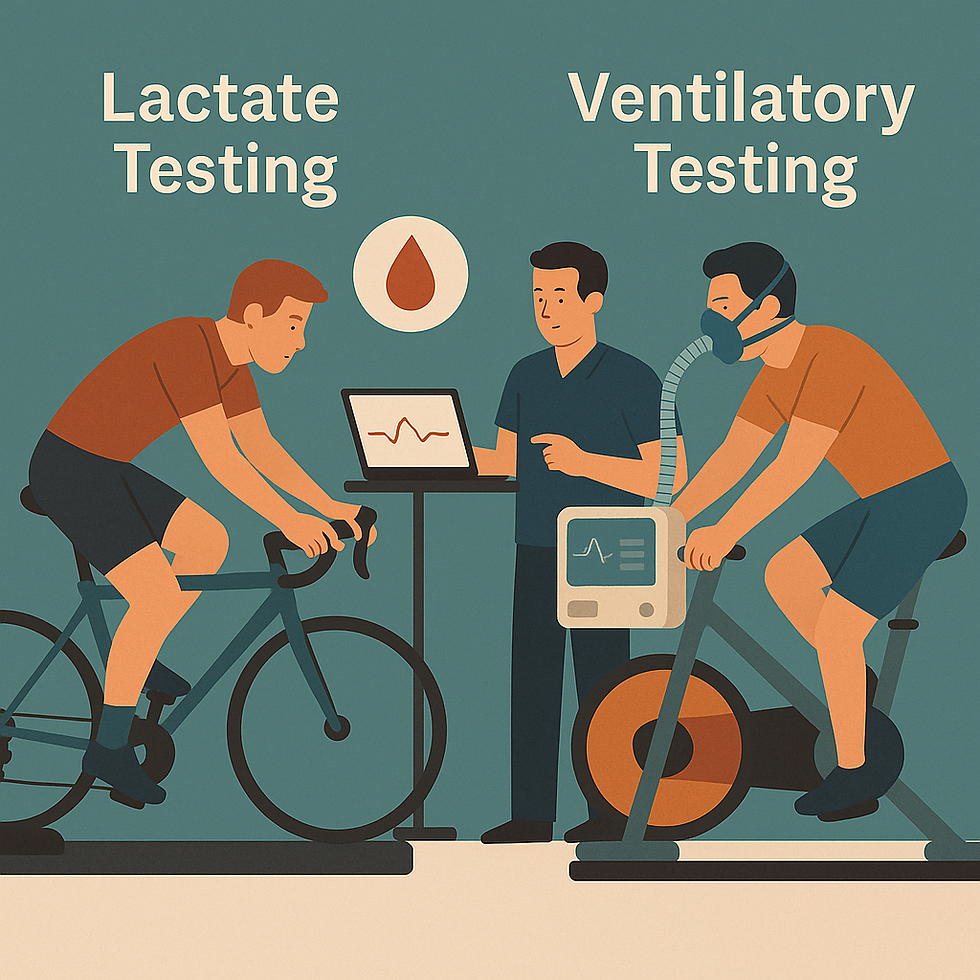Common errors in lactate testing vs. breath tests
- PAIRFS

- 3 days ago
- 3 min read
Lactate tests and breathing tests are two methods commonly used to determine an athlete's thresholds (threshold 1, threshold 2, endurance zone, critical intensity). However, they do not measure the same phenomena and do not present the same sources of error.
In this article, we analyze the most frequent errors made when interpreting or using these tests, and we explain why breathing — particularly with ZoneX — offers a more accurate, reproducible and relevant alternative for field training.
1. Confusing lactate threshold and ventilatory threshold
❌ Common mistake
Believing that the rise in blood lactate corresponds exactly to ventilatory breakdown (VT2). In reality, the two phenomena are linked but do not occur at exactly the same time .
✔ What science says
Ventilation reacts to CO₂ produced in response to metabolic acidosis.
Lactate accumulates in the blood before respiration registers the ventilatory compensation.
💡 Result: → A lactate test may underestimate or overestimate the true ventilatory threshold.
2. Testing lactate without standardizing conditions
Blood lactate is extremely sensitive to:
the temperature,
food,
stress,
hydration,
the type of warm-up,
the pre-test timing.
❌ Error
Perform a lactate test on an empty stomach one day, after coffee another day, or after a bad night's sleep.
✔ Consequence
→ Unstable values, poorly estimated thresholds.
✔ Respiratory benefit
Respiration reflects the internal physiological response and is not influenced by these external variables. ZoneX analyzes thresholds directly via ventilatory transitions.
3. Performing a lactate test that is too short or too long
A poorly structured lactate test leads to major errors:
❌ Typical errors
Stops that are too short (< 3 minutes) → lactate not stabilized
Stages that are too long (> 8 min) → fatigue impairs the response
Incorrectly calibrated intensity → misleading cardiac drift
✔ Respiratory benefit
The ventilation reacts in real time . → ZoneX detects ventilatory transitions precisely, → without depending on blood stabilization or the duration of the stages.
4. Consider that lactate = absolute internal intensity
Lactate measures a metabolic outcome , not internal effort. Two individuals can produce the same lactate level for very different reasons:
difference in muscle fibers,
mitochondrial density,
respiratory strategy,
training status.
❌ Incorrect conclusion
“My level is 4 mmol/L, so I am at my threshold.”
→ This value varies from one athlete to another.
✔ What research shows
Ventilatory thresholds (VT1/VT2) are much more individual and reproducible (Wasserman, Poole & Jones).
5. Forgetting that breathing is an active regulator — not a byproduct
In lactate tests, respiration is often ignored or considered secondary.
❌ Error
Focusing solely on power and lactate → we miss the respiratory dynamics.
✔ What studies show
Breathing:
stabilizes acidosis
allows for ventilatory compensation.
reflects the CO₂/H⁺ balance,
indicates very precisely when the body can no longer hold on .
ZoneX exploits this respiratory dynamic in real time.
6. Believing that lactate tests are superior because they are "scientific"
In reality, lactate tests are useful… but only in a laboratory, with a strict protocol , carried out by an experienced professional.
❌ Risks on the ground
bad blood test
contamination through sweat,
bad hair drop,
post-meal lactate abnormalities.
✔ Modern solution
The on-board breath test , like ZoneX, uses:
minute ventilation
respiratory rate
respiratory dynamics,
automatic threshold detection.
→ It is reproducible, portable, non-invasive.
Conclusion: Breath tests are more reliable, more practical, and better suited to the field
Lactate tests are interesting, but:
sensitive to numerous external factors,
dependent on human manipulation,
variables depending on the technique,
difficult to achieve in real-world conditions.
Breath tests — especially with ZoneX — provide:
✔ Automatic detection of VT1 & VT2
✔ Reproducibility of thresholds
✔ Continuous analysis, not just one-off analysis
✔ No invasive manipulation
✔ Real-time adaptation of your training zones
✔ Direct relevance to the field
👉 ZoneX transforms a laboratory protocol into a tool accessible on every output.
References:
Reproducibility of Ventilation Thresholds in Trained Cyclists During Ramp Cycle Exercise (Weston & Gabbett, 2001)




Comments